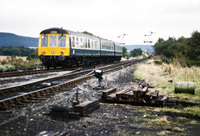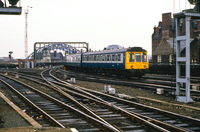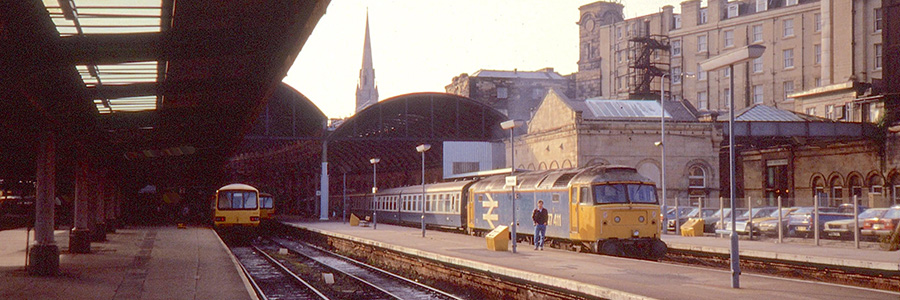Western Region DMUs in the North East
Problems with new Pacer units (wheel cracks and faulty gearboxes) in the Newcastle area in Autumn 1987 meant sets from other areas were sent to help out. This included 64ft suburban and Cross-Country Western Region types that were unusual to the area which had almost exclusively been 57ft low density vehicles since DMUs were introduced in 1955.
They lasted until Spring 1988.
Manchester was also having problems with poor reliability of Class 142s, and some 116 power cars due to be condemned were sent there to help out[1]. These came from Tyseley, Cardiff Canton and Chester beginning June 1987. Newton Heath had had Class 116s before, two sets were there in 1976/7.
By August the gearbox problems on the Class 142 and 143s at Manchester and Newcastle were increasing and loco-hauled and conventional DMU replacements were becoming more and more common. On August 10 there were 17 service cancellations at Newcastle due to non-availabilty of the Pacers and replacement old stock[2] — the problem was not just the Pacers, but the ageing First Generation fleet at Heaton. Two additional loco-hauled sets were introduced from August 24 to help work the local services to Berwick, Middlesbrough and Carlisle.[3]
To assist the crisis Cardiff Canton sent four sets to Heaton, they had a transfer date of 6 September 1987:
C313 53847 59040 53900 (Class 116) C316 53856 59364 53909 (Class 116) C590 51058 59418 51087 (Class 119) C591 51059 59471 51102 (Class 119/118/119)
C591 had been running with a Class 108 centre car (59382) but it was switched shortly before the move with Class 118 TCL 59471 coming from Class 118 set C470. Canton was probably able to release these sets as Sprinters were being delivered there ready for being introduced to the Cardiff Valleys in October 5 1987[4].
The sets were noted as moving northwards from Gloucester on the 9th and 10th September. The first formation contained the two Class 116 sets (C313 and C316), the second the 119s (C590 and C591).[5]
Both the Class 116 sets had been gangwayed, but had no toilets, 59040 being a TS and 59364 a TC. The 119 sets had two vehicles with toilets, and as toilets were expected on the Newcastle services the Class 116 and 119 non-brake power cars were switched to create these initial formations, each set now having one vehicle with a toilet:
53847 59040 51087 (116 DMBS / 116 TS / 119 DMSL) 53856 59364 51102 (116 DMBS / 116 TC / 119 DMSL) 51058 59418 53900 (119 DMBC / 119 TSL / 116 DMS) 51059 59471 53909 (119 DMBC / 118 TCL / 116 DMS)
After some repairs the four sets are noted as entering traffic on the 15th on Tyneside local services and in Teeside including to Whitby. While some of the Welsh markings were left on the Class 116 exteriors the route maps were removed from the interiors.[5]

In the image cars 51087 59040 53847 are seen awaiting departure from the then platform 5 at Newcastle with an evening commuter service on 16 September. Adjacent in the then platform 4 are Mk 1 coaches — probably a locomotive-hauled Pacer substitution — these were invariably three coaches in length, and their positioning relative to the DMU suggests a locomotive may be 'trapped' at the buffer stops. Graeme Phillips Collection.
The 119/119/116 set 51058 + 59418 + 53900 was noted working Newcastle-Carlisle services on 18 September[6].

Class 116 DMBS 53856 presumably with 116 TC 59364 and 119 DMS 51102) crossing Byker Viaduct on 21 September. John Carter.

Class 119 DMSL 51102 with Class 116 cars 59364 and 53856 stand in what was then platform 7 of Newcastle station on 22 September. The car number has an E-prefix — at a time when the regional prefixing was being abandoned - yet the former WR set number C591 remains. Graeme Phillips Collection.

On the left is Class 101 DMBS E53250 and on the right Class 119 DMBC 51059, seen at Newcastle on 23 September. Graeme Phillips Collection.

Class 116 DMS 53909, complete with Welsh dragon symbol on cab front, is seen in what was then platform 11 (now platform 9) of Newcastle station on 24 September. The destination blind reads Ystrad Mynach. Graeme Phillips Collection.

The image shows the unusual sight of a Class 119 at Battersby, North Yorkshire, on the rural Esk Valley line between Middlesbrough and Whitby. Taken on the 9 October, closest is 51058, presumably with 59418 and 53900. Graeme Phillips Collection.
They were not the only first generation DMU vehicles to be sent to help out to help at Newcastle, as Class 101s came from places such as Hull Botanic Gardens, Swansea Landore and Eastfield, but 101s were nothing unusual at Newcastle, having been been a permanent feature there for the previous thirty years. The influx of vehicles also allowed the remaining Met-Camm driving trailers to be taken out of use.
The number of first generation vehicles allocated to Heaton each month from April 1987 to April 1988 were:
One of the new Met-Camm arrivals, transferred from Botanic Gardens on 4/10/87 (BG depot closed on this date), was soon noted running with some of the suburban vehicles[7]:
53214 59471 53909 (101 DMBS / 118 TCL / 116 DMS)

53214 had replaced Class 119 DMBC 51059, which was subsequently noted with a Met-Camm DMS. The image shows the pair at Darlington in November 1987. John Carter.
A Class 118 set (C465: 51307 + 59477 + 51322) was on allocation lists as being transferred from Canton to Heaton on 4 October, but the move was subsequently cancelled.
Heaton did get two Class 118 sets (one with a Class 101 centre car), but these came from Tyseley. Some (if not all) of the power cars still had remains of Valleys markings, as well as West Midland Markings.
The vehicles, with a transfer date of 25/10/87 (arriving at Heaton on the 26th[8]), were:
TS351 51308 59475 51323 TS352 51309 59123 51324

The image shows a Class 118 in Newcastle on 13 November. DMS 51323 carries the WM (West Midlands PTE) logo and red triangle across the cab front (minus the Welsh dragon that would usually accompany this). The car behind appears to be a Class 101 TBS(L). Graeme Phillips Collection.
In November the Class 143s were still unreliable and regular cancellations were still normal — loco-hauled substitutions continued into December.[9]
1988
Formations noted circa January 1988 were:[10]
51308 + 53847 (118 DMBS / 116 DMBS) 53220 + 59475 + 51323 (101 DMBS / 118 TCL / 118 DMS) 53205 + 53900 (101 DMBS / 116 DMS)

Cars 51323 + 59475 + 53220 are seen about to enter Newcastle station on 20 January. The first two are Class 118s, 53220 just visible at the rear was a Class 101. Leading car 51323 carries the red chevron, which was usually accompanied by a red dragon. 20/01/1988. Graeme Phillips Collection.
By the end of February 1988 the availability of Heaton's Class 143s was "improving week by week"[11], and the first generation units began to be transferred away or withdrawn.
First to go were the two ex-Tyseley 118s, reallocated to Newton Heath on 26/2/88 (but moving on the 25th[12]). They did not take the centre cars they arrived with (59123 and 59471, both would eventually be withdrawn from Heaton), but they did take the ex-Canton 118 TCL 59471. Their stay in Manchester was brief, being dispatched for scrap on 21 March.[13]
Soon after the Class 116 power cars and one Class 116 centre car (59364) moved to Chester. This move was on ER lists as 28 February but LMR lists as 10 March — they were hauled away on the 9th March[12].
Three of the Class 119 power cars were withdrawn on 31 March. Of the ex-WR vehicles that left just one power car (51058 — a 119 DMBC) and three centre cars (59040 — a 116 TS; 59418 — a 119 TSL; and 59475 — a 118 TCL).
An image on flickr shows 59475 running between two Met-Camm DMBS in May 1988 suggests the remaining WR vehicles were out of use soon after.

The image shows Class 119 DMBC 51059 out of use at Thornaby depot on 19 June. Jerry Glover.
The two Class 119 vehicles were withdrawn on 9 September, the 118 TCL 59475 on 6 December. The final vehicle, 116 TS was officially stored in the period ending 7 October 1989 and finally withdrawn on 10 May 1990, ending the brief use of Western Region designs in the North East.
The full list of ex-Western Region suburban / Cross-Country DMU types allocated to Heaton in this period:
Arrive Depart 51058 119 DMBC 06/09/87 CF 09/09/88 W 51059 119 DMBC 06/09/87 CF 31/03/88 W 51087 119 DMSL 06/09/87 CF 31/03/88 W 51102 119 DMSL 06/09/87 CF 31/03/88 W 53847 116 DMBS 06/09/87 CF 10/03/88 CH 53856 116 DMBS 06/09/87 CF 10/03/88 CH 53900 116 DMS 06/09/87 CF 10/03/88 CH 53909 116 DMS 06/09/87 CF 10/03/88 CH 59040 116 TS 06/09/87 CF 10/05/90 W (stored p/e 07/10/89) 59364 116 TC 06/09/87 CF 10/03/88 CH 59418 119 TSL 06/09/87 CF 09/09/88 W 59471 118 TCL 06/09/87 CF 26/02/88 NH 51308 118 DMBS 25/10/87 TS 26/02/88 NH 51309 118 DMBS 25/10/87 TS 26/02/88 NH 51323 118 DMS 25/10/87 TS 26/02/88 NH 51324 118 DMS 25/10/87 TS 26/02/88 NH 59475 118 TCL 25/10/87 TS 06/12/88 W
The problems with new stock (in traffic and late deliveries) was also delaying the elimination of vehicles containing blue asbestos, originally scheduled for the end of 1987.[14]
Problems with the second generation stock continued — the final image shows 47 411 in Newcastle Central with a four cariage train to Hartlepool as a Pacer substitute on the afternoon of 15 September 1988. Alan Grange.

References
- ⋏ "Multiple Matters" by Steve Knight, p61 October 1987 Rail Enthusiast
- ⋏ "Traction Talk", p59 November 1987 Rail Enthusiast
- ⋏ p446 October 1987 Railway Observer
- ⋏ "South Wales Newslines" by Deryck Lewis, p13 October 1987 Rail Enthusiast
- ⋏ a b p488 November 1987 Railway Observer
- ⋏ p482 November 1987 Railway Observer
- ⋏ "Traction Talk", p59 December 1987 Rail
- ⋏ p13 January 1988 Railway Observer
- ⋏ "Multiple Matters" by Steve Knight, p37 February 1988 Rail
- ⋏ "Traction Talk" p61 April 1988 Rail
- ⋏ "Traction Talk", p60 June 1988 Rail
- ⋏ a b p218 May 1988 Railway Observer
- ⋏ p264 June 1988 Railway Observer
- ⋏ "Asbestos Stock to run in 1987" p15 November 1987 Rail Enthusiast
The Railway Observer is the journal of the Railway Correspondence and Travel Society
For a brief spell in the late 1960s South Gosforth had four Class 116 sets but never previously had Class 118s or Class 119s.


